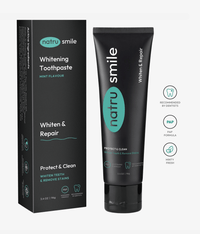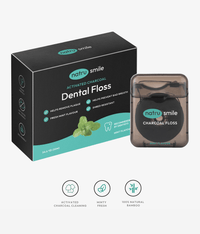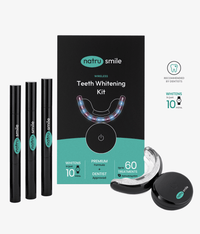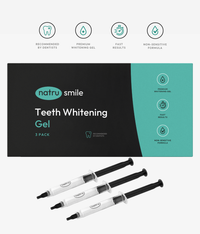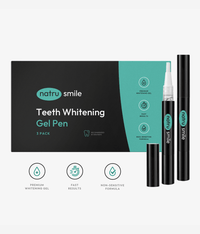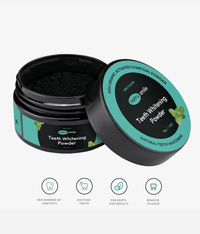
All products are certified by dental expert Dr. Greg Grillo
We will demystify the art of brushing with an electric toothbrush, reveal secret tips for choosing the perfect toothpaste, and handpick a selection of top-rated devices tailored to your unique needs.
But that's not all - prepare to dive into expert advice on keeping your trusty brush in pristine condition and uncover answers to burning questions about compatibility with braces. This comprehensive guide is designed to empower you with everything you need to master electric toothbrush wizardry and keep those pearly whites sparkling, no matter what dental challenges you face.
Ready? Let's embark on this electrifying journey into the world of high-tech teeth cleaning techniques.
Proper Ways To Use Electric Toothbrush
After buying an electric toothbrush, the first step is to ensure it's fully charged. Most models come with a charging base – to charge the toothbrush, simply place it on the base and allow it to charge overnight or for as many hours as recommended by the manufacturer. A fully charged toothbrush will perform optimally, ensuring you get the best possible clean.
Maintain The Integrity Of Your Brush
In order to ensure that your electric toothbrush is functioning efficiently and giving you the best possible clean, it's essential to inspect your toothbrush head and bristles on a regular basis. Check for signs of wear, like frayed or splayed bristles, and make sure the head is securely attached.
It's advisable to replace the toothbrush head every three to four months, or even sooner if the bristles are visibly worn or frayed. This will help maintain optimal cleaning performance and oral hygiene.
Prepare Your Toothbrush
Before beginning to brush your teeth, take a moment to prepare your electric toothbrush. Start by moistening the bristles with water, then apply a pea-sized amount of toothpaste to the bristles. Turn on the toothbrush, allowing the bristles to spin, mix, and evenly disperse the toothpaste, making sure it's fully coated. This ensures that the toothpaste reaches all areas of your mouth more effectively during brushing.
Divide Your Mouth Into Four Quadrants
To get the most out of your electric toothbrush and to ensure you're thoroughly cleaning every area of your mouth, it's helpful to mentally divide your mouth into four separate quadrants: upper right, upper left, lower right, and lower left. Adopting this strategy will promote optimal cleaning, along with proper brushing time.
It's recommended to spend 30 seconds brushing each quadrant, making up a total of 2 minutes – the ideal brushing duration recommended by dentists. Using a timer may be useful to help you adhere to this guideline, and some electric toothbrushes even come with built-in timers to make this easier. With these techniques, you'll be sure to make the most of your electric toothbrush and properly maintain your oral health.
Proper Toothbrushing Techniques
Let’s take a look at best practices for brushing your teeth.
1. Place Toothbrush Bristles Along The Gum Line
To begin with, position the toothbrush bristles at a 45-degree angle along the gum line. This is an essential step because it helps to effectively remove plaque and bacteria from the critical junction where your teeth and gums meet - a place where it's crucial to maintain good oral hygiene to prevent gum disease and cavities.
2. Brush From Outer To Inner Tooth Surfaces
Next, start by focusing on the outer surfaces of your teeth, carefully brushing with small, circular motions. Once complete, proceed to the inner surfaces of the teeth, making sure to be gentle yet thorough. Lastly, ensure you clean the chewing surfaces of your teeth using a back-and-forth motion. By adopting this sequential approach, you'll ensure all parts of the teeth are cleaned effectively - helping to prevent any dental issues from arising.
3. Clean Biting Surfaces, Your Tongue, And Soft Palate
In addition to cleaning your teeth thoroughly, it's important to not forget about other parts of your mouth that are more susceptible to plaque buildup and bacteria growth. Make sure you thoroughly brush your tongue using gentle, sweeping motions, focusing on the back area, and moving forward toward the tip of the tongue. This helps to eliminate the bacteria responsible for bad breath, as well as improve overall oral health.
After that, take the time to brush the roof of your mouth, also known as the soft palate, which serves as another common bacteria-harboring spot. Lastly, clean the biting surfaces (the cuspids and molars) of your teeth to remove any trapped food particles and to prevent further plaque buildup, using a back-and-forth or circular motion.
By following these detailed and comprehensive steps, you'll be well on your way to maintaining optimal oral hygiene and keeping your mouth in great condition.
Maintaining Oral Hygiene With Proper Techniques
There are certain ways you can brush your teeth with an electric toothbrush to ensure proper oral hygiene. Let’s take a closer look.
Brush Gently And Thoroughly
When using an electric toothbrush, gentle pressure is all that is required to effectively remove plaque and food particles lodged between your teeth. Overbrushing with hard pressure may cause damage to your tooth enamel and gum tissue, leading to a multitude of dental issues.
Opt for a brush that has a built-in pressure sensor; this will remind you to avoid applying excessive force while cleaning your teeth, ensuring that you maintain a gentle brushing routine.
Floss Between Your Teeth
Flossing plays a crucial role in maintaining good oral health. It is essential for removing plaque and food particles from the spaces between your teeth that your toothbrush may not be able to access. Incorporating daily flossing into your oral hygiene routine is highly recommended, ensuring that you're using floss or an interdental cleaner to maximize the thoroughness of your dental care.
Use An Antiseptic Mouth Rinse
To further improve your oral health and prevent the development of black dots or other dental issues, consider using an antiseptic mouth rinse. Antiseptic mouthwashes have the ability to kill bacteria in your mouth, reducing plaque build-up and the risk of developing tooth decay or gum disease.
To incorporate mouth rinsing into your daily routine, use an antiseptic mouthwash once a day after brushing and flossing your teeth. This additional step can greatly enhance your overall oral hygiene and protect your teeth from various dental problems.
Proper Toothbrush Storage: Tips And Recommendations
To maintain an effective and clean electric toothbrush, it's important to store it correctly. Here are some storage tips to keep your toothbrush free from germs and in the best condition for your oral health:
-
Place your toothbrush upright: After cleaning your electric toothbrush, it should be placed in an upright position, ensuring that the bristles have ample space to air-dry. This helps to eliminate any residual moisture that may lead to bacterial growth.
-
Allow the bristles to dry completely: Before putting any protective cover or case back on the brush head, make sure that the bristles have dried thoroughly. This prevents the accumulation of bacteria, mold, or mildew within the brush head cover.
- Use a clean and ventilated storage area: Your toothbrush storage location should be by a sink, preferably in a toothbrush holder. The area should be well-ventilated and, if possible, exposed to natural light to discourage bacterial growth.
Electric Toothbrushes And Braces: Are They A Suitable Combination?
Many people wonder if it's safe and effective to use an electric toothbrush with braces. The answer is yes! In fact, using an electric toothbrush may even be more beneficial for cleaning your teeth and braces than relying solely on manual brushing techniques.
There are several reasons why electric toothbrushes can provide superior cleaning results for individuals with braces:
-
Advanced cleaning technology: Electric toothbrushes utilize advanced technology that allows them to move in various motions, such as oscillating and pulsating, which helps to effectively dislodge plaque and food debris from around brackets and wires.
-
Easier access to hard-to-reach areas: Braces can make it difficult to clean certain areas of the teeth and gums. Electric toothbrushes come with specially designed brush heads that easily maneuver around braces, ensuring that even hard-to-reach spots are cleaned thoroughly.
-
Gentle on braces and gums: Electric toothbrushes are designed to apply the right amount of pressure for effective cleaning while being gentle on your braces and gums. Some models even come with pressure sensors to alert you if you're pressing too hard.
- Timers for efficient cleaning: Many electric toothbrushes feature built-in timers that encourage users to brush for the recommended two minutes. This helps to ensure that each area of your mouth, including around your braces, receives an adequate amount of cleaning and attention.
In summary, electric toothbrushes can be a great option for people with braces, as they offer improved cleaning abilities and user-friendly features that enhance your overall oral hygiene.
Electric Or Sonic: Choosing A Toothbrush For Use With Braces
Wearing braces often necessitates adjusting your oral hygiene routine to ensure your teeth and gums stay healthy during orthodontic treatment. Choosing the right toothbrush to use with braces can be challenging, especially when trying to decide between electric and sonic options.
In this section, we'll provide a thorough comparison of electric versus sonic toothbrushes and help you make an informed decision on which one is better suited for individuals with braces.
Electric Toothbrushes
Electric toothbrushes have rotating or oscillating bristle heads that effectively clean your teeth, reaching difficult areas around braces. They are convenient for people with limited dexterity, as the brush head does much of the work. Many electric toothbrushes also have built-in timers and pressure sensors to enhance the brushing experience.
Pros Of Electric Toothbrushes
- Can effectively clean around braces
- Easy to use for those with dexterity issues
- Additional features such as timers and pressure sensors aid in effective brushing
Cons Of Electric Toothbrushes
- May not clean as thoroughly as sonic toothbrushes
- Replacement brush heads can be expensive
- Bulkier and less portable than manual toothbrushes
Sonic Toothbrushes
Premium sonic toothbrushes boast high-frequency vibrations that create waves of cleaning power, breaking up plaque and sweeping away debris. This advanced technology tends to provide a more thorough and efficient cleaning experience even when used with braces.
Pros Of Sonic Toothbrushes
- High-frequency vibrations for superior cleaning
- Usually come with multiple cleaning modes
- Can clean areas that are hard to reach with other toothbrushes
Cons Of Sonic Toothbrushes
- Generally more expensive than electric toothbrushes
- Replacement brush heads can be pricey
While both electric and sonic toothbrushes are suitable for use with braces, sonic toothbrushes may provide a more thorough cleaning experience due to their high-frequency vibration technology. Ultimately, the choice between an electric or sonic toothbrush largely depends on your personal preferences, budget, and specific dental care needs.
No matter which toothbrush you opt for, it's essential to maintain proper oral hygiene habits and consistently clean around your braces. Speak with your orthodontist or dentist for further recommendations on the best toothbrush choice for your particular situation.
How To Keep Your Electric Toothbrush Clean And Well-Maintained
Caring for your electric toothbrush and keeping it clean is crucial for maintaining optimal oral hygiene. By following a few simple steps, you can ensure your toothbrush stays in tip-top shape and continues to deliver the best possible results for your dental health.
In this section, we'll provide a detailed explanation of a few easy-to-follow methods for keeping your electric toothbrush clean and well-maintained.
1. Use A UV Toothbrush Sanitizer For Thorough Sanitization
A UV toothbrush sanitizer is a beneficial device that uses ultraviolet (UV) light to kill bacteria, viruses, and other microorganisms that may linger on your toothbrush head. To effectively minimize the risk of bacterial growth and accumulation, consider investing in a sanitizer and regularly using it to sanitize your toothbrush.
2. Clean Your Electric Toothbrush Head Thoroughly After Each Use
To ensure that your toothbrush head remains free of residual toothpaste, food particles, and debris, make it a habit to rinse it under warm, running water after each session. Give it a gentle rub with your fingers or even use a soft brush to reach between the bristles for a more thorough cleaning.
3. Let Your Toothbrush Air-dry In An Upright Position
After cleaning your toothbrush head, it's essential to let it air-dry in an upright position. Doing this will not only facilitate proper drainage but also prevent the growth of bacteria by circulating air through the toothbrush bristles. Consider using a toothbrush holder or stand to keep your toothbrush upright and dry efficiently.
4. Change Your Toothbrush Head Every 3 Months Or As Needed
The American Dental Association recommends replacing your toothbrush head every three to four months or sooner if the bristles become visibly worn or frayed. Regularly changing your toothbrush head ensures maximum cleaning efficiency, maintains consistent bristle strength, and reduces the risk of bacterial accumulation.
By following these steps, you can maintain and extend the life of your electric toothbrush and make sure it stays clean and effective in helping you achieve excellent oral hygiene.
Maintaining Optimal Oral Hygiene: Preventative Measures You Can Take
In order to reduce the likelihood of black dots appearing on your teeth, as well as maintain good overall oral health, it is important to follow certain preventative measures. Below we have listed several tips that can help ensure you maintain optimal oral hygiene habits.
Don't Share Your Toothbrush
It is crucial to remember that sharing a toothbrush can transfer harmful bacteria among users and significantly increase the risk of oral infections. To prevent this, always use your own personal toothbrush and store it separately from the toothbrushes of other individuals in your household.
Use A Travel Case When Traveling
When traveling, a toothbrush travel case can help protect your electric toothbrush from picking up dirt, debris, and bacteria on your trip. Keep in mind that it's essential to make sure your toothbrush is completely dry before placing it in the travel case to prevent the growth of mold or mildew.
Consider A Toothpaste Dispenser
Another effective way to reduce the risk of bacterial contamination is by choosing a new toothpaste dispenser. These devices dispense just the right amount of toothpaste onto your brush without cross-contamination between toothbrushes or the need to touch the tube of toothpaste with your hands, further reducing the spread of germs.
Clean Your Toothbrush After Every Use
Cleaning your electric toothbrush thoroughly after every use is a vital practice to help maintain its cleanliness and overall effectiveness. By rinsing it under running water for a few seconds, you can wash away any residual toothpaste, food particles, or debris that may have accumulated on the brush during use. This will help keep your toothbrush in optimal condition, leading to better overall oral hygiene.
Bottom Line
In summary, the proper use of an electric toothbrush can greatly contribute to overall improved oral hygiene and promote the health of your teeth and gums. Following this comprehensive guide, encompassing everything from brushing techniques to maintenance and storage, can make a remarkable difference in the state of your oral well-being.
With a greater emphasis placed on brushing techniques and other aspects of dental care, you'll be on your way to a healthier, brighter smile. Enjoy the journey towards better oral health and happy brushing!


